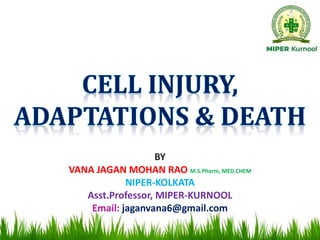
Cell injury, adaptations and death
- 1. BY VANA JAGAN MOHAN RAO M.S.Pharm, MED.CHEM NIPER-KOLKATA Asst.Professor, MIPER-KURNOOL Email: jaganvana6@gmail.com
- 2. Overview of Cell Injury • Cells actively control the composition of their immediate environment and intracellular milieu within a narrow range of physiological parameters (“homeostasis”) • Under physiological stresses or pathological stimuli (“injury”), cells can undergo adaptation to achieve a new steady state that would be compatible with their viability in the new environment. • If the injury is too severe (“irreversible injury”), the affected cells die.
- 3. Causes of Cell Injury • Hypoxia and ischemia • “Chemical” agents • “Physical” agents • Infections • Immunological reactions • Genetic defects • Nutritional defects • Aging
- 4. Mechanisms of Cell Injury: General Principles • Cell response to injury is not an all-or-nothing phenomenon • Response to a given stimulus depends on the type, status, and genetic make-up of the injured cell • Cells are complex interconnected systems, and single local injuries can result in multiple secondary and tertiary effects • Cell function is lost far before biochemical and subsequently morphological manifestations of injury become detectable
- 5. General Biochemical Mechanisms 1. Loss of energy (ATP depletion, O2 depletion)
- 6. 1. Loss of energy (ATP depletion, O2 depletion) 2. Mitochondrial damage (“permeability transition”) General Biochemical Mechanisms
- 7. 1. Loss of energy (ATP depletion, O2 depletion) 2. Mitochondrial damage 3. Loss of calcium homeostasis General Biochemical Mechanisms
- 8. 1. Loss of energy (ATP depletion, O2 depletion) 2. Mitochondrial damage 3. Loss of calcium homeostasis 4. Defects in plasma membrane permeability General Biochemical Mechanisms
- 9. 1. Loss of energy (ATP depletion, O2 depletion) 2. Mitochondrial damage 3. Loss of calcium homeostasis 4. Defects in plasma membrane permeability 5. Generation of reactive oxygen species (O2 , 2 2H O , OH ) and other free radicals General Biochemical Mechanisms
- 10. Neutralization of Free Radicals 1. Spontaneous decay 2. Superoxide dismutase (SOD): 2O + 2H → O + H O 2 2 2 2 3. Glutathione (GSH): 2OH + 2GSH → 2H2O + GSSG 4. Catalase: 2H2O2 → O2 + H2O 5. Endogenous and exogenous antioxidants (Vitamins E, A, C and β-carotene)
- 11. Free Radical-Induced Injury • If not adequately neutralized, free radicals can damage cells by three basic mechanisms: 1. Lipid peroxidation of membranes: double bonds in polyunsaturated membrane lipids are vulnerable to attack by oxygen free radicals 2. DNA fragmentation: Free radicals react with thymine in nuclear and mitochondrial DNA to produce single strand breaks 3. Protein cross-linking: Free radicals promote sulfhydryl-mediated protein cross-linking, resulting in increased degradation or loss of activity
- 12. “Reperfusion” Damage • If cells are reversibly injured due to ischemia, restoration of blood flow can paradoxically result in accelerated injury. • Reperfusion damage is a clinically important process that significantly contributes to myocardial and cerebral infarctions • Exact mechanisms are unclear, but – Restoration of flow may expose compromised cells to high concentrations of calcium, and – Reperfusion can result in increase free radicals production from compromised mitochondria and the circulating inflammatory cells
- 13. Chemical Injury • Direct damage such as binding of mercuric chloride to sulfhydryl groups of proteins • Generation of toxic metabolites such as conversion of CCl4 to CCl3 free radicals in the SER of the liver
- 14. Cellular Adaptation to Injury • Cellular adaptations can be induced and/or regulated at any of a number of regulatory steps including receptor binding, signal transduction, gene transcription or protein synthesis • The most common morphologically apparent adaptive changes are – Atrophy (decrease in cell size) – Hypertrophy (increase in cell size) – Hyperplasia (increase in cell number) – Metaplasia (change in cell type)
- 15. Atrophy • Atrophy is the shrinkage in cell size by loss of cellular substance • With the involvement of a sufficient number of cells, an entire organ can become atrophic • Causes of atrophy include decreased workload, pressure, diminished blood supply or nutrition, loss of endocrine stimulation, and aging • Mechanisms of atrophy are not specific, but atrophic cells usually contain increased autophagic vacuoles with persistent residual bodies such as lipofuscin Ex: BRAIN ATROPHY
- 16. Hypertrophy • Hypertrophy is an increase in cell size by gain of cellular substance • With the involvement of a sufficient number of cells, an entire organ can become hypertrophic • Hypertrophy is caused either by increased functional demand or by specific endocrine stimulations • Not only the size, but also the phenotype of individual cells can be altered in hypertrophy • With increasing demand, hypertrophy can reach a limit beyond which degenerative changes and organ failure can occur Ex: CARDIAC HYPERTROPHY
- 17. Hyperplasia • Hyperplasia constitutes an increase in the number of indigenous cells in an organ or tissue • Pathological hyperplasia if typically the result of excessive endocrine stimulation • Hyperplasia is often a predisposing condition to neoplasia
- 18. Metaplasia• Metaplasia is a “reversible” change in which one adult cell type is replaced by another adult cell type • Metaplasia is a cellular adaptation in which indigenous cells are replaced by cells that are better suited to tolerate a specific abnormal environment • Because of metaplasia, normal protective mechanisms may be lost • Persistence of signals that result in metaplasia often lead to neoplasia Ex: Intestinal metaplasia of esophagus
- 19. Pathologic Calcification • Dystrophic calcification is the abnormal deposition of calcium phosphate in dead or dying tissue • Dystrophic calcification is an important component of the pathogenesis of atherosclerotic disease and valvular heart disease • Metastatic calcification is calcium deposition in normal tissues as a consequence of hypercalcemia: – Increased PTH with subsequent bone resorption – Bone destruction – Vitamin D disorders (intoxication, Sarcoidosis, Williams syndrome) – Renal failure with 2º PTH
- 20. Cell Death
- 21. Coagulative Necrosis vs. Apoptosis
- 22. Highlight Events in Apoptosis
